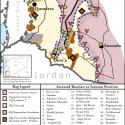 |
 |
Southern Syria Deal Fails to Constrain Iran, al Qaeda

By Genevieve Casagrande, Patrick Hamon, and Bryan Amoroso
Key Takeaway: The ‘de-escalation zone’ in Syria brokered by the U.S, Russia, and Jordan threatens the strategic interests of the U.S. and its allies. The deal fails to constrain Iran and al Qaeda despite the decreased violence in Southwest Syria. Iran continues to consolidate its presence along the Golan Heights through a network of proxy forces while retaining significant positions in Southern Syria. Russia remains both unwilling and unable to prevent Iran from establishing a permanent foothold in the south, contrary to Russian President Vladimir Putin's assurances. The failure to prevent Iran’s entrenchment threatens Israel, increasing the likelihood of further Israeli military intervention. Al Qaeda, meanwhile, has leveraged the ceasefire and diminishing support to non-jihadist opposition groups to deepen its presence along the Syrian-Jordanian border.
The ‘de-escalation zone’ in Southern Syria will ultimately preserve rather than roll back Iran’s long-term position. The U.S., Russia, and Jordan agreed upon a Memorandum of Principles for Southern Syria on November 8. The deal includes an “exclusionary zone” that requires foreign forces – including Iran and Lebanese Hezbollah - to depart from a five-to-seven kilometer buffer zone along the agreed-upon line of contact. The buffer zone at its maximum extent places foreign forces up to thirty kilometers away from the Syrian-Jordanian border and Golan Heights. The exclusion zone seeks to complement the pre-existing ‘de-escalation zone’ in Southern Syria brokered on July 7. Iran has nonetheless set conditions to preserve its safe haven in Southern Syria. Iran and Lebanese Hezbollah initially withdrew many of their foreign forces from areas along the Syrian-Jordanian border after the ‘de-escalation zone’ went into effect on July 9. However, Iran left behind friendly local paramilitary groups and a small number of foreign fighters to continue to cultivate and recruit local groups not covered by the exclusion zone but ultimately subordinate to Iran. Iran is also continuing its build-up on the outskirts of this zone, which places its forces less than an hour drive from the Golan Heights.
The failure of the ‘de-escalation zone’ to meaningfully constrain Iran risks further intervention by Israel along the Golan Heights. Israeli Prime Minister Benjamin Netanyahu and other Israeli officials have expressed concern with the terms of the exclusion zone in Southern Syria, stressing that the deal does not meet their “unequivocal demands” to bar Iran and its proxies from the Golan. The deal likewise will not prevent Iran from developing permanent military basing in Syria, another Israeli redline. Israel has likewise reiterated its continued freedom of action to confront Iran in Syria. Israeli officials have repeatedly said that Iran risks crossing a red line that could prompt further Israeli military action against Iran and Lebanese Hezbollah. Lebanese Hezbollah has also signaled its readiness for a possible military escalation and is rumored to have begun deploying elite forces from Syria to Southern Lebanon. The failure of the U.S. to constrain Iran raises the possibility of a conflict between Iran and Israel in Southern Syria that could ultimately spread into Southern Lebanon, particularly given Lebanon’s worsening political crisis following the resignation of Lebanese Prime Minister Sa’ad Hariri.
Al Qaeda has exploited the ‘de-escalation zone’ to develop a new durable safe haven along the Syrian-Jordanian border. Al Qaeda’s Syria affiliate Hay’at Tahrir al Sham (HTS) will capitalize on the diminishing external support to vetted anti-Bashar al Assad regime opposition groups to expand its footprint in Southern Syria. The Trump Administration issued orders that will reportedly end all covert support to opposition groups in Syria by December 2017. The cutoff will lead to the cancellation of salaries for thousands of rebel fighters even as opposition groups and affiliated governance structures are already struggling to maintain basic security and infrastructure - such as prisons and courthouses - across Southern Syria. HTS is positioning itself to fill this governance and military vacuum. HTS has also resumed offensive operations in Southern Syria in order to bolster its legitimacy within the opposition as the guarantor of the continued revolution against the Assad regime. HTS alongside other opposition factions temporarily relieved the pro-regime siege on the town of Beit Jinn in the Western Ghouta Suburbs of Damascus near the Golan Heights on November 3 after clashes that included at least one suicide bombing. The joint operations room leading the offensive urged opposition groups to disregard “international pressure” to adhere to the ‘de-escalation zone’ and instead “join [their] brothers” to continue the fight against Assad. Meanwhile, a recent spike in unclaimed assassinations of opposition commanders and governance officials could also indicate an active campaign by al Qaeda to marginalize opposition groups backed by the U.S. and Jordan in Southern Syria. HTS has employed similar tactics to eliminate potential competitors in Idlib Province since 2014. Al Qaeda ultimately seeks to leverage its role in joint military structures, support to local governance, and targeted violence against resistant opposition officials to further integrate itself within the opposition and establish a new safe haven for Salafi-Jihadism along the Syrian-Jordanian border.